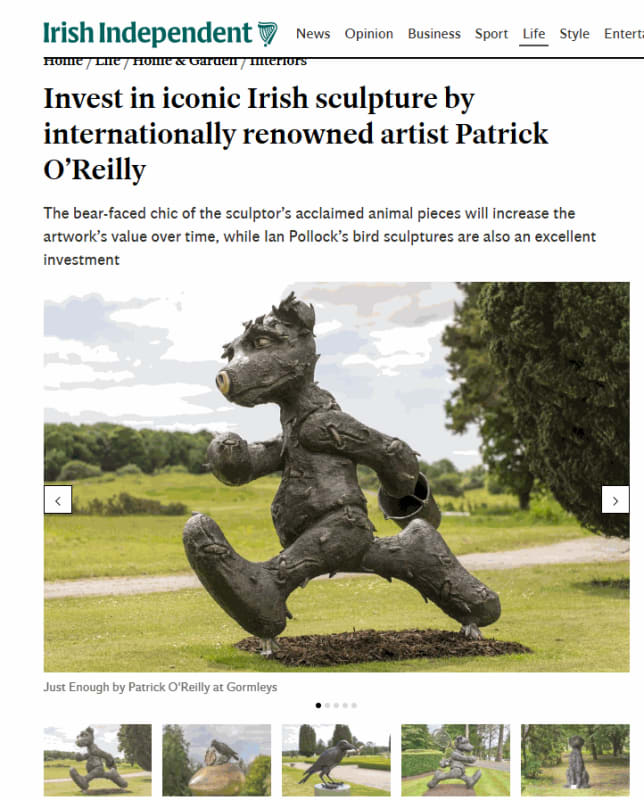Anyone buying an expensive piece of outdoor sculpture must surely think about investment. The standard advice is to buy what you love, but the future is unknowable and circumstances change. A time may come when you want to sell and, if that happens, you’ll want to break even. A good return on your investment would be better still.
“When someone is buying an Andy Warhol print, they’ll certainly ask about its investment potential,” says art dealer Oliver Gormley. “With sculpture, only a few people will ask that question. When people buy sculpture for their gardens, it’s more about enjoyment than investment.” It seems naive to spend a whack of money on anything without considering its potential resale value, but Ireland’s relationship with contemporary sculpture is in its honeymoon era.
“Until a few years ago, Irish people rarely thought about sculpture,” Gormley says. “Now they’re appreciating it a lot more.” Contributing factors include exhibitions like Art + Soul, Gormley’s massive annual extravaganza of sculpture, paintings and prints. This year, Art + Soul runs in Castlemartyr, Cork, until June 29 and at the Culloden Estate & Spa, Belfast, from July 26 to August 31. These are free exhibitions, open to the public, with corresponding packages available from the hotels for those who want to stay.
In general, the advice for would-be investors in sculpture is the same as for those investing in paintings or prints. “Buy an established artist with an international reputation,” Gormley says. “Their work will generally go up in price.”
His top investment tip at Art + Soul is Patrick O’Reilly (b. 1957). O’Reilly’s work has sold all over the world and, so far, held its value. “Some of the pieces he sold 15 or 20 years ago have started to come back on the market at auction. They’re making the same price as his new sculptures and the people who bought them would have paid a lot less.”
The intrinsic value of the material is one of the main differences between bronze sculpture and other types of art. The price of bronze increases year-on-year. Fuel and production costs have doubled in the past five years.
Gormley recommends that anyone considering their purchase as an investment should buy from the artist’s most iconic series. “With O’Reilly, the bears are the most iconic, then his Irish wolfhounds. Those are your two options. Bears or dogs.”
In general, avoid experimental pieces and pieces of lesser quality. Do your research. Ask yourself if this is a good example of the artist’s work. Take your time and get the right piece. “If you’re happy with it, you’ll probably always be happy with it. If you put it into an auction, I’d be confident that you’ll get more than you paid for it.”
In a recent interview for MyArtBroker, Richard Polsky, author of I Sold Andy Warhol (Too Soon), gave similar advice to people investing in prints. “Whilst personally rewarding to own something a little atypical for the artist, it rarely pays off as well from an investment perspective. There is a reason why some artists make it big. Usually, it comes down to being an innovator and contributing something new to art history.” With Warhol, it’s soup cans and celebrities; with David Hockney, it’s swimming pools.
This can be frustrating for artists who want to make new work. The Welsh-Irish sculptor Barry Flanagan (1941-2009), known worldwide for his hares, famously complained: “I do so much work that I love but everybody wants my hares.” O’Reilly may come to feel the same way about bears. A 120cm-high bear sculpture by Patrick O’Reilly costs €59,000; a 135cm-high wolfhound costs €49,000. On an indoor scale, a 30cm bear costs €6,500 and a 50cm dog is €9,000. “Go in at the level you’re comfortable with,” Gormley says.
His second recommendation for investment is Ian Pollock (b. 1950), whose best-known sculptures are of birds (€3,000 to €25,000). “There’s something about Ian’s bird sculptures that resonates with people,” Gormley says. “He makes other work, but the birds are the most iconic.”
Art + Soul also includes several small-scale sculptures by Salvador Dali, made under licence by Dali Universe since the artist’s death. Regarding their investment value, Gormley’s on the fence. “They seem to have held their value reasonably well, but people buy them because they want a Dali rather than because they want an investment.”
By Eleanor Flegg,
Friday 27th June 2025

